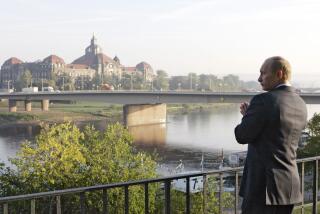East Germans Turn the Tables on the Much-Feared Secret Police : East Bloc: Spies brave enough to report for work are now searched by citizen guards, who protect files now sealed pending the trials of the Communist hierarchy.
DRESDEN, East Germany — The glum spies obediently open their briefcases and pockets for the citizens now standing guard outside security police headquarters, and a table outside the gate holds petitions demanding that the compound be turned into a nursing home.
Freshly painted insults cover the thick wall that once concealed microphones and cameras. East Germans accustomed to scurrying by with heads bowed now brazenly snap pictures out front and glare at the police still brave enough to report for work.
The tables have turned on East Germany’s once-dreaded Stasis, as members of the Staatsicherheitsdienst, (State Security Service) are called, after 40 years of playing enforcer for a cruel and corrupt Communist regime.
“We have an old saying in German that you should always be kind to the little people,” said one Dresdener, “because tomorrow they may sit as your judge.”
Tomorrow has indeed come, with a brand of righteous anger that teeters on the edge of anarchy, as everyday East Germans retaliate against four decades of harassment, intimidation and persecution.
Across the country, thousands of citizens have stormed and occupied secret police headquarters. There, they stand guard over files now sealed by military prosecutors pending the trials of former leader Erich Honecker and the Communist hierarchy.
The transitional government, led by a Communist, has agreed to dismantle the labyrinthine internal spy network and grant amnesty to political prisoners. Officials describe the whole secret police system as “an erroneous policy.”
Unlike Romania’s ruthless Securitate, which put up a bloody resistance to Eastern Europe’s pro-democracy movement, East Germany’s Stasis are running so scared that their panicky chief issued a public appeal for compassion and complained bitterly about discrimination against his subordinates.
Although there have been no serious clashes, provincial newspapers reported that one high-ranking Stasi killed himself with his service revolver as a mob of unarmed citizens pressed in on the headquarters in the southern city of Suhl.
And with tens of thousands of the police--the exact number is classified--now being reassigned to jobs in the coal mines, railroads and at border crossings, integration is proving troublesome.
Help-wanted notices often declare that “Stasis need not apply.” Officials say many work collectives have flatly refused to take on the former secret police despite the severe labor shortage triggered by the mass emigration of East Germans to West Germany in recent months.
Others, such as church officials in Dresden, are quietly urging psychological help for the Stasis and urging the public not to resort to vigilante justice.
“There still is a real potential for violence, because nobody wants to take these people. For us, a spy is a spy. But we all have to live together,” said Steffan Heitmann, an Evangelical Church lawyer and a member of the independent citizen’s group guarding Dresden’s Stasi compound since it was occupied Dec. 5.
What amounted to a small, bloodless coup began that day when the pro-democracy group New Forum received a tip that something was up at the security police headquarters. There had been reports elsewhere of Stasis burning documents that might incriminate party leaders, and citizens were growing angry. The Stasi headquarters in Erfurt had been stormed by protesters the day before.
Arnold Vaatz, a physicist active in Dresden’s branch of New Forum, hurried over to the Stasi compound. There were already 50 people milling outside--a crowd that mere weeks before would have been considered an illegal assembly whose participants would certainly have been arrested by the security police.
A military prosecutor arrived and entered the building with a committee of 12 citizens, according to Vaatz. Archives and files were sealed, and computers were secured. There were so many files, Vaatz said, “that it took us six hours just to seal one floor.”
“There are rooms and rooms filled to the ceiling with files,” he said, “so many that it would take two or three lifetimes to read them all. And that’s just Dresden, where there were only about 3,500 Stasis, not counting the unofficial informants.”
Within two hours that night, the cluster of 50 people had grown to 50,000, witnesses said. “Like Hitchcock’s birds,” Vaatz commented.
The crowd jeered the Stasis and demanded to be let in. As people pressed up against the gate, witnesses said, the beleaguered security police finally opened the doors.
Steffan Heitmann can still see the look of sheer terror on the face of the Dresden Stasi chief, who had to be locked in his own office under New Forum guard for nearly 24 hours as a precaution against lynch-mob justice.
“People kept streaming in throughout the night to look,” Heitmann said. “Some would run home for tools to force open locked drawers, and neighbors were bumping into each other in the offices, saying, ‘Oh, you’re here, too!’ Nobody ever dreamed they would see such a thing.”
Similar citizen raids followed throughout East Germany, prompting the Stasi commander, Lt. Gen. Wolfgang Schwanitz, to hold a bizarre press conference later that week in East Berlin.
Schwanitz claimed that vigilantes had paralyzed security police offices in four major cities, including Dresden, and ransacked Stasi apartments in the compounds, leaving the secret police and their families “fearing for life and limb.”
He also asserted that there were “many, many injuries” but could not provide details. When pressed by reporters, he conceded that no one was hospitalized or seriously hurt. Western reporters who later visited some of the supposedly besieged Stasi compounds found peaceful occupations, with no evidence of violence.
“Many Stasis may want the situation to escalate, to give them an excuse to bring in the military and police,” Vaatz said.
But so far, the impotent Stasis have seemed more defensive than dangerous.
“My hands are clean, and the hands of the overwhelming majority of my employees are clean,” insisted Schwanitz. He is a career security policeman who became chief in November after the minister of state security, Wolfgang Mielke, resigned with the entire Politburo and was later arrested on corruption charges.
The Stasis, said Schwanitz, “were just honest people trying to do an honest job . . . (and) they should not be held responsible for the erroneous policy of the former leadership.”
That policy included opening the mail and bugging the telephones of untold numbers of everyday East Germans and planting undercover agents in workplaces to ferret out citizens with unacceptable attitudes or opinions.
“They were the real thugs,” said one Western diplomat, speaking on condition of anonymity.
“They operated on two principles,” said Heitmann, the church lawyer. “First, that every citizen of East Germany was a potential security risk, and second, that one can only be secure if one knows everything. Everything.” He continued:
“If you applied for permission to travel abroad, your neighbors and co-workers would be questioned. They would ask whether your marriage was good, whether you had a mistress.
“Just speaking your mind could land you in jail. If you thought differently than others, you were a security risk. You couldn’t even drive by this building without feeling afraid. The fear was endless. You always felt watched over.”
One elderly man snapping photographs outside the Dresden headquarters said his grown son was imprisoned by the security police for 13 months after trying to escape East Germany.
“The West Germans bought his freedom for 65,000 marks, and he’s now living in West Germany,” said the father, who declined to give his name. “What the Stasis did is an obscenity. Now, they’re getting what they deserve.
“My son had friends who were put in the water room of that building. It was a torture chamber in the cellar. The room would fill up with water, higher and higher, until the person was in danger of drowning.”
The independent citizens’ group said it has found no evidence of torture. However, some cellar walls did have water marks, and long, dark tunnels leading to holding cells were lit by red lights that blinked, apparently to contribute to a prisoner’s disorientation.
Paper shredders in the Stasi office were already stuffed full when citizens burst in, and “it is impossible to know what’s missing,” said Heitmann.
More to Read
Sign up for Essential California
The most important California stories and recommendations in your inbox every morning.
You may occasionally receive promotional content from the Los Angeles Times.










